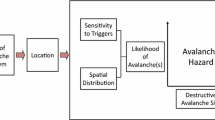Abstract:
The Tunguska airburst, which devastated a taiga forest over an area greater than 2,000 km2 in a remote region of Central Siberia in 1908, is a classic example of extraterrestrial encounter discussed in the asteroid/comet impact hazard and risk assessment literature (e.g. Longo 2007; Carusi et al. 2007). Although it is generally agreed that the cosmic body caused damage by bursting in the air rather than through direct impact on the Earth’s surface, the Tunguska event is often referred to as an impact event. To the best of our knowledge, no detailed studies have been performed to quantify the risk of a similar-sized event over a populated region. We propose here a straightforward probabilistic risk model for Tunguska-type events over the continental United States and use established risk metrics to determine the property (buildings and contents) and human losses. We find an annual average property loss of ~USD 200,000/year, a rate of ~0.3 fatalities/year and ~1.0 injuries/year ranging from a factor 3 below and to a factor 3 above the indicated values when a reasonable rate uncertainty for Tunguska-type events is taken into account. We then illustrate the case of an extreme event over the New York metropolitan area. While we estimate that this “nightmare” scenario would lead to ~USD 1.5 trillion of property loss, ~3.9 millions of fatalities and ~4.7 millions of injuries, such event is almost impossible (occurrence once every ~30 million years) and should only be considered as an illustrative example.





Similar content being viewed by others
References
Bailey ME, Markham DJ, Massai S, Scriven JE (1995) The 1930 August 13 ‘Brazilian Tunguska’ event. Observatory 115:250–253
Bailie M (2007) The case for significant numbers of extraterrestrial impacts through the late Holocene. J Quat Sci 22:101–109
Ben-Menahem A (1975) Source parameters of the Siberian explosion of June 30, 1908, from analysis and synthesis of seismic signals at four stations. Phys Earth Planet Int 11:1–35
Boslough MBE, Crawford DA (2008) Low-altitude airbursts and the impact threat. Int J Impact Eng 35:1441–1448
Brown P, Spalding RE, ReVelle DO, Tagliaferri E, Worden SP (2002) The flux of small near-Earth objects colliding with the Earth. Nature 420:294–296
Carusi A, Carusi A, Pozio L (2007) May land impacts induce a catastrophic collapse of civil societies? Comet/asteroid impacts and human society, an interdisciplinary approach. Springer, Berlin, pp 419–436 Chapter 25
Collins GS, Artemieva N, Wünnemann K, Bland PA, Reimold WU, Koeberl C (2008) Evidence that Lake Cheko is not an impact crater, Terra Nova, 20. doi:10.1111/j.1365-3121.2008.00791.x
Gasperini L, Alvisi F, Biasini G, Bonatti E, Longo G, Pipan M, Ravaioli M, Serra R (2007) A possible impact crater for the 1908 Tunguska Event, Terra Nova, 19. doi:10.1111/j.1365-3121.2007.00742.x
Gasperini L, Bonatti E, Longo G (2008) Lake Cheko and the Tunguska Event: impact or non-impact?, Terra Nova, 20. doi:10.1111/j.1365-3121.2008.00792.x
Gasperini L, Bonatti E, Albertazzi S, Forlani L, Accorsi CA, Longo G, Ravaioli M, Alvisi F, Polonia A, Sacchetti F (2009) Sediments from Lake Cheko (Siberia), a possible impact crater for the 1908 Tunguska Event. Terra Nova, 21. doi:10.1111/j.1365-3121.2009.00906.x
Glasstone S, Dolan PJ (1977) The effects of nuclear weapons, United States Department of Defense and Energy Research and Development Administration, Washington
Gusiakov VK (2007) Tsunami as a destructive aftermath of oceanic impacts, comet/asteroid impacts and human society, an interdisciplinary approach. Springer, Berlin, pp 247–263 Chapter 14
Harris A (2008) What spaceguard did. Nature 453:1178–1179
HAZUS-MH. Available at http://www.fema.gov/plan/prevent/hazus/
Kovacs P, Hallak A (2007) Insurance coverage of meteorites, asteroid and comet impacts—issues and options, comet/asteroid impacts and human society, an interdisciplinary approach. Springer, Berlin, pp 469–478 Chapter 28
LandScan™ (2005) Global Population Database, Oak Ridge, TN: Oak Ridge National Laboratory. Available at http://www.ornl.gov/landscan/
Longo G (2007) The Tunguska event, comet/asteroid impacts and human society, an interdisciplinary approach. Springer, Berlin, pp 303–330 Chapter 18
Longo G, Di Martino M, Andreev G, Anfinogenov J, Budaeva L, Kovrigin E (2005) A new unified catalogue and a new map of the 1908 tree fall in the site of the Tunguska Cosmic Body explosion, asteroid-comet hazard, Institute of Applied Astronomy Russian Academy of Science, St Petersburg, Russia, pp 222–225
Melosh HJ, Beyer RA (1998) Crater. Available at http://www.lpl.arizona.edu/tekton/crater.html
Office of Technology Assessment (1979) The effects of nuclear war, NTIS order #PB-296946
Risk Management Solutions (2008) RMS® U.S. Industry exposure database and industry loss curves user documentation 2008
Serra R, Cecchini S, Galli M, Longo G (1994) Experimental hints on the fragmentation of the Tunguska Cosmic Body. Planet Space Sci 42(9):777–783
Shoemaker EM (1983) Asteroid and comet bombardment on the Earth. Annu Rev Earth Planet Sci 11:461–494
Simon SB, Grossman L, Clayton RN, Mayeda TK, Schwade JR, Sipiera PP, Wacker JF, Wadhwa M (2004) The fall, recovery, and classification of the Park Forest meteorite. Meteorit Planet Sci 39:625–634
Smolka A (2006) Natural disasters and the challenge of extreme events: risk management from an insurance perspective. Phil Trans R Soc 364:2147–2165
Stokes GH (2003) Study to determine the feasibility of extending the search for near-earth objects to smaller limiting diameters. Report of the NASA NEO Science Definition Team, http://neo.jpl.nasa.gov/neo/report.html
Acknowledgments
The authors wish to thank two anonymous referees for their valuable comments that significantly enhanced the manuscript. We acknowledge the Oak Ridge National Laboratory for providing the 2005 LandScan™ Global Population Database used in this study.
Author information
Authors and Affiliations
Corresponding author
Rights and permissions
About this article
Cite this article
Mignan, A., Grossi, P. & Muir-Wood, R. Risk assessment of Tunguska-type airbursts. Nat Hazards 56, 869–880 (2011). https://doi.org/10.1007/s11069-010-9597-3
Received:
Accepted:
Published:
Issue Date:
DOI: https://doi.org/10.1007/s11069-010-9597-3




